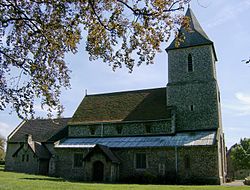Sandridge
| Sandridge | |
| Hertfordshire | |
|---|---|
 St Leonards, Sandridge | |
| Location | |
| Grid reference: | TL175105 |
| Location: | 51°46’51"N, 0°18’14"W |
| Data | |
| Population: | 4,808 |
| Post town: | St Albans |
| Postcode: | AL4 |
| Local Government | |
| Council: | St Albans |
| Parliamentary constituency: |
Hitchin and Harpenden |
Sandridge is a small village in Hertfordshire, sitting between St Albans and Wheathampstead.
The village church is St Leonard's and is thought to date back to 1119.
Contents
About the village
The village has three pubs: The Green Man, The Rose and Crown and The Queen's Head.
The local football team is Sandridge Rovers FC, who play in the Hertfordshire Senior County League.
In 2008 the Woodland Trust announced plans to create a new forest north of Sandridge.[1] The 857 acres of woodland are to be called Heartwood Forest.[2]
Early history
The earliest recorded mention of Sandridge is in the year 796, in which the village is recorded as part of the lands of the Mercian Kings which was given by King Egfrith, son of Offa, to the monastery of St Albans in the first year of his reign.
The Second Battle of St Albans
In February 1461 the final skirmishes of the Second Battle of St Albans took place in and around Sandridge as the Earl of Warwick, for the Yorkists, retreated towards Nomansland.
Sandridge was one of the earlier homes of the great general, John Churchill, 1st Duke of Marlborough, and his famous wife, Sarah, a favourite of Queen Anne. The title Baron Sandridge was given to Churchill by James II in 1685, the first title Churchill received in the English peerage, though he had been created Baron Eyemouth n the Scottish peerage in 1682 King Charles II.
In 1939 the first secret Wireless Intercept Station of the Second World War was constructed by the GPO at the top of Woodcock Hill. It was the first of a group of stations dedicated to Diplomatic Interception with rows of radio operators listening to the wireless traffic between Germany, Italy, Tokyo and other enemy embassies around the world. Messages intercepted at Sandridge were sent to Bletchley Park for decryption. The results were vital to the Government who used the information to make important decisions about the course of the war. After the War the station became part of the Diplomatic Wireless Service under GCHQ and in 1973 the site was taken over by the Home Office for Police research.
References
- ↑ Alexandra Barham (2008-07-30). "Huge forest planned". St Albans & Harpenden Review. http://www.stalbansreview.co.uk/news/3555635.Huge_forest_planned/. Retrieved 2009-04-02.
- ↑ "Mickey Mouse brings Disney magic to Sandridge forest". The Herts Advertiser. 2009-03-19. http://www.hertsad.co.uk/content/herts/news/story.aspx?brand=HADOnline&category=News&tBrand=HertsCambsOnline&tCategory=newslatestHAD&itemid=WEED19%20Mar%202009%2015%3A49%3A06%3A560. Retrieved 2009-04-02.
- Facts about Sandridge
- Some dates in the history of St Leonard's Church, Sandridge, A paper read at a meeting of the St Albans and Hertfordshire Architectural and Archeological Society, held at Sandridge, June 24, 1900 by the Rev J.A. Cruikshank M.A.
Outside links
| ("Wikimedia Commons" has material about Sandridge) |